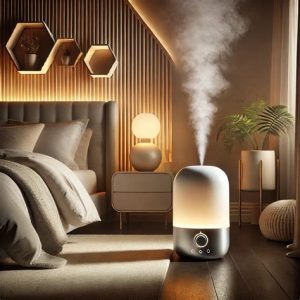The Impact of Humidifiers on Electronics In Home
The gentle, almost hypnotic drift of vapor from a humidifier is a modern comfort. It’s a direct assault on the desiccated air that winter heating systems inflict upon our homes. You feel the difference almost immediately. Your skin feels less like parchment. Your throat doesn’t scratch with every breath. It’s a tangible improvement in personal comfort, a small act of environmental control in a chaotic world. But as I watched the mist from my own new device curl through the lamplight the other evening, my gaze drifted across the room. It landed on my laptop, my television, the gaming console tucked neatly on a shelf. A thought, unbidden and slightly unsettling, wormed its way into my mind. What is this invisible cloud of water actually *doing* to all of this expensive, delicate technology?
We are curators of a miniature electronic ecosystem. Our homes are galleries for our gadgets. We obsess over processor speeds and pixel densities. We guard against physical drops and electrical surges with protective cases and pricey surge protectors. Yet we often remain blissfully unaware of the ambient atmosphere we’re asking these devices to exist within. Humidity is the silent variable, the unseen player in the longevity game. It can be a benevolent guardian or a patient, insidious saboteur. Using a humidifier without understanding its mechanical audience is like fertilizing a garden without knowing which plants are toxic. The intention is pure. The consequences can be unexpectedly complex.
Navigating the Atmospheric Tightrope: The Science of Survival
To truly appreciate the delicate dance between electronics and humidity, you have to abandon the idea of “good” and “bad.” It’s not that simple. The relationship is one of profound sensitivity to extremes. These devices, for all their silicon sophistication, crave a state of equilibrium. They want what I’ve come to think of as the atmospheric sweet spot. Not a desert. Not a swamp. Something perfectly, sustainably in the middle.
This entire dynamic hinges on the interplay between two fundamental physical forces. They are the twin antagonists in this story: the desiccating specter of **Static Electricity** and the creeping menace of **Condensation**.
The Arid Enemy: Static Electricity’s Silent Strike
Let’s talk about dry air first. When the relative humidity plummets, the air becomes an excellent insulator. It holds electrical charge like a battery, just waiting for a release. You shuffle across a carpet in your wool socks. You’re not just walking; you’re a storm cloud building potential. Then you reach for your laptop or a USB cable. In that instant, the charge you’ve accumulated seeks the path of least resistance to the ground. It leaps from your fingertip to the device.
You feel a tiny, sharp zap. A minor annoyance. To the intricate circuitry inside your gadget, however, it’s an apocalyptic event. This is an Electrostatic Discharge (ESD). We’re talking about a voltage spike that can easily reach tens of thousands of volts, albeit for a microscopic duration. It’s a lightning strike on a nanometer scale. The effects can be instantaneous and catastrophic—a dead motherboard, a fried solid-state drive. More insidiously, it can cause latent damage. The component is wounded, weakened, destined to fail mysteriously weeks later. I learned this the hard way years ago, assembling a computer on a dry winter day. I touched a RAM module without properly grounding myself. There was no visible spark, no dramatic smoke. But the module was dead on arrival. A hundred-dollar lesson delivered by an invisible force.
Microscopic Wounds: The pathways on a microchip are unimaginably small. An ESD event can vaporize these tiny tracks, creating permanent, invisible breaks.
The Weakening: Even if it doesn’t kill a component outright, the intense heat of a discharge can degrade semiconductor materials, shortening the component’s overall lifespan.
The Saturated Threat: Condensation and the Rust Within
Now, let’s flip the script. You’ve enthusiastically cranked up the humidifier. The air feels thick and tropical. You’re breathing easy, but you’ve now introduced a different kind of peril. The threat here isn’t a sudden, dramatic zap. It’s a slow, pervasive invasion.
The principle is simple physics. Warm air can hold more moisture than cold air. When that warm, moisture-laden air comes into contact with a cooler surface, the air cools down at that boundary. It can no longer hold all its water vapor. The excess condenses, transforming from an invisible gas into liquid water. You see it on a cold windowpane or a frosty beverage can.
Now, apply this to your electronics. Consider your gaming console after a multi-hour session. Its internal components are hot. Its metal heat sinks, its processor, its graphics card—they’re radiating warmth. You turn it off. It begins to cool. If the surrounding air is heavily saturated with humidity, that cooling process actively draws moisture *inside* the chassis. The water vapor condenses on the now-cooling circuit boards. It beads up on solder joints. It clings to connectors.
This invasion leads to two primary failure modes:
- The Immediate Catastrophe: Short-Circuiting. Liquid water is a conductor. When it bridges two electrical points that are not meant to be connected, it creates a short circuit. Power takes this new, disastrous path. The result is often immediate and total failure. It’s a digital heart attack. One moment your device is fine; the next, it’s a silent, inert brick.
- The Slow Decay: Corrosion. This is the more common, and in many ways more frightening, outcome. Moisture accelerates the oxidation of metal. It’s the same process that turns iron into rust, but it’s happening on the gold contacts of your RAM, the copper traces on your motherboard, the delicate pins of your processor. You’ll see it as a faint green or white powder-like crust. This corrosion increases electrical resistance, degrades signal integrity, and leads to a slow, steady decline. The device becomes unstable. It crashes randomly. Data gets corrupted. It’s a death by a thousand cuts. I once opened an old desktop computer that had lived its life in a humid Florida garage. The motherboard had a faint, greenish patina in places, like moss growing on a forest rock. The machine was unreliable, and now I knew why. It was being eaten alive from the inside.
A Domestic Inventory: Your Gadgets in the Balance
Not all electronics face these threats equally. Their design, their function, and their placement in your home create a unique risk profile. Let’s take a walk through a digitally saturated household and assess the vulnerabilities.
The Living Room: The High-Stakes Entertainment Hub
This room often houses your most significant investments, both financially and emotionally.
Gaming Consoles (PlayStation, Xbox, Nintendo Switch): These are thermal powerhouses. They are designed to generate immense heat and dissipate it quickly through vents and fans. This creates a perfect storm for condensation. The cycle is relentless: heat up during a gaming marathon, cool down during inactivity. High humidity turns this natural cycle into a destructive process, inviting moisture inside with every power-down. Furthermore, the dust that naturally accumulates inside mixes with this moisture to form a grimy, slightly conductive sludge that can gum up fans and insulate heat sinks, causing overheating.
Flat-Screen Televisions: The quest for ever-thinner profiles has packed incredibly complex circuitry into a vanishingly small space. There’s little room for error—or for moisture. Condensation can form on internal power supply boards or the controller boards for the display itself. I’ve encountered TVs that simply wouldn’t turn on, only to find corroded, green-tinged components on the internal power supply, a direct result of prolonged exposure to a damp environment.
High-Fidelity Speakers and Audio Receivers: The soul of a speaker is its driver, often a paper or composite cone. This material is hygroscopic; it absorbs moisture from the air. High humidity can cause these cones to warp or lose their rigidity, fundamentally altering the speaker’s tonal quality and clarity. Meanwhile, the bare metal terminals on the back of speakers and receivers can tarnish and corrode, creating a poor connection that degrades the audio signal before it even reaches the speaker.
The Home Office: The Nerve Center of Productivity
In our era of remote work, this room has transformed into a mission-critical command center.
Laptops and Desktop Computers: These are arguably the most vulnerable systems in your home. They are riddled with entry points: USB ports, audio jacks, ventilation grilles, keyboard seams. They are a complex ecosystem of different materials and temperatures. The potential for both ESD damage during handling and internal condensation is high. The sheer density of expensive components—the CPU, the GPU, the RAM—makes them a target-rich environment for corrosion.
Printers, Especially Inkjet Models: These are the divas of the electronic world, exceptionally fussy about their environment. High humidity causes paper to absorb moisture, making it limp and prone to jamming as it tries to navigate the precise rollers inside the machine. More critically, it affects the ink itself, potentially leading to clogged print heads as the ink’s viscosity changes. The result is streaky, poor-quality prints and frustrating, time-consuming cleaning cycles.
The Bedroom: The Supposed Sanctuary
This is where we seek rest, and ironically, where we often run humidifiers for our own comfort throughout the night. But it’s also a room full of sleep-time companions.
Smartphones and Tablets: We subject these devices to the most dramatic environmental shifts. We carry them from a climate-controlled car into a humidified bedroom, or from an air-conditioned office into the humid outdoors. These rapid transitions are a recipe for condensation. You may have even seen it temporarily fog the camera lens from inside the device. That’s a clear warning sign that moisture is penetrating sealed areas, potentially leading to long-term damage.
Smart Home Hubs and Displays (Amazon Echo Show, Google Nest Hub): These always-on devices contain microphones and speakers. Over time, excessive moisture in the air can degrade the sensitive diaphragms in these components. The result can be a muffled speaker or a microphone that becomes less responsive to your voice commands, slowly eroding the convenience they were designed to provide.
The Art of Coexistence: A Pragmatic Peace Treaty
So, does this mean you should banish your humidifier to the attic? Absolutely not. The benefits for respiratory health and personal comfort are undeniable and valuable. The goal is not elimination, but intelligent management. You must become the mediator in the relationship between your personal comfort and your technology’s well-being.
The Universal Sweet Spot: 40-60% Relative Humidity
This is the magic range. It’s the consensus among device manufacturers, conservators in museums (who protect artifacts far more sensitive than our TVs), and HVAC experts. Maintaining an indoor relative humidity between 40% and 60% strikes the perfect balance. It provides enough ambient moisture to virtually eliminate the risk of static electricity discharge. Simultaneously, it keeps the air dry enough to prevent the widespread condensation that leads to corrosion. It’s the climate-controlled equivalent of a perfect spring day for your gadgets.
Actionable Strategies for a Harmonious Home:
- Embrace the Hygrometer. This is your most important tool. You cannot rely on a vague sense of “it feels okay.” A hygrometer gives you data. These inexpensive devices are available at any hardware store or online. Place one in the primary room where you use both your humidifier and your most valuable electronics. It’s your dashboard, your objective truth-teller in a world of subjective feeling.
- Invest in an Intelligent Humidifier. If you’re serious about climate control, choose a humidifier with a built-in humidistat. This allows you to set a target humidity level. The machine will then cycle on and off automatically to maintain that precise level. It’s the ultimate “set it and forget it” solution, providing peace of mind and protecting your devices around the clock.
- Become a Placement Purist. Location is everything. Never, under any circumstances, place a humidifier directly next to an electronic device. The direct plume of mist is a concentrated threat. Maintain a minimum distance of three to six feet from any tech. Ensure the mist has ample space to diffuse and dissipate into the general room air. Avoid placing it on a shelf above electronics, where condensation can drip down.
- Prioritize Air Circulation. Stagnant air is the enemy. It allows pockets of high humidity to form. Use a ceiling fan on a low setting. Employ a small oscillating fan to keep the air moving. Periodically cracking a window, even for just a few minutes, facilitates a crucial exchange of air, preventing moisture from building up to dangerous levels.
- Understand Your Humidifier Type. The two main types are cool mist (ultrasonic and evaporative) and warm mist (vaporizers). Ultrasonic models, which use high-frequency vibrations to create a fine cool mist, are popular but can disperse white mineral dust from tap water throughout the room. This dust can settle on and inside your electronics. Using distilled or demineralized water in an ultrasonic humidifier mitigates this risk. Warm mist models boil water, creating steam, which can slightly raise the room’s ambient temperature. There’s no definitive “best” type for electronics, but understanding their mechanics helps you make an informed choice and anticipate their secondary effects.
It’s a dance of awareness. The hum of the humidifier and the silent glow of a standby light on a console don’t have to be in conflict. By acknowledging the invisible conversation between water vapor and circuitry, you move from being a passive occupant to an active steward of your environment. You can enjoy the palpable comfort of properly humidified air without that nagging fear in the back of your mind. You can breathe deep, knowing your digital world is breathing easy, too.
FAQ’s
Q: Can using a humidifier damage my electronics?
A: Yes, if the humidity level becomes too high. Excessive moisture in the air can lead to condensation inside electronic devices, potentially causing short circuits, corrosion of internal components, and mold growth.
Q: What is the ideal humidity level to protect my electronics?
A: The recommended indoor humidity level for both human comfort and electronic safety is between 30% and 50%. Using a hygrometer to monitor levels can help you stay within this safe range.
Q: Are some electronics more at risk from humidity than others?
A: Yes. Devices with minimal protective casing or those that generate significant heat, like game consoles and computers, can be more susceptible. Sensitive equipment like musical instruments or vintage electronics are also at higher risk.
Q: What precautions should I take when using a humidifier in a room with electronics?
A: Place the humidifier at least a few feet away from any electronic devices. Ensure the room is well-ventilated, use a humidifier with a built-in humidistat to auto-regulate moisture, and regularly clean the unit to prevent mold and mineral dust dispersal.




